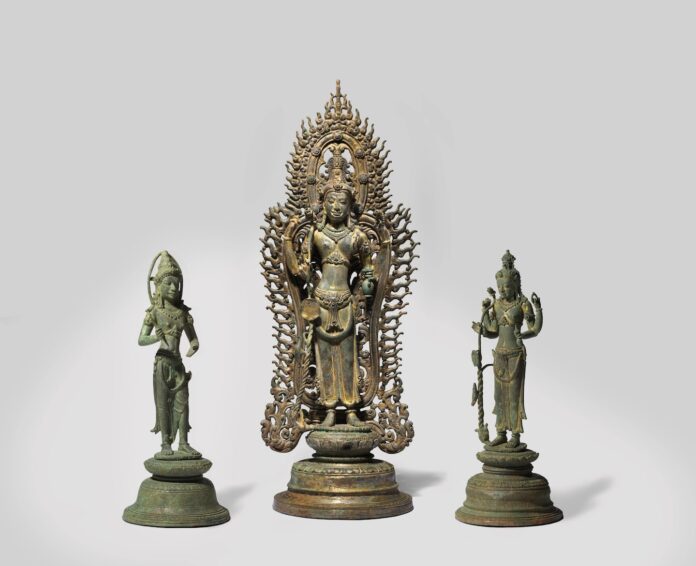Those pieces, like the three statues in the Australian government-owned gallery, were bought from Douglas Latchford, the disgraced British antiquities dealer who was indicted in the United States in 2019 for wire fraud conspiracy and other crimes related to dealing in stolen objects. He died before going to trial.
Prosecutors say Latchford falsified records to claim the relics were legitimately obtained, when the pieces had been looted from temples and other sites, mostly in Cambodia, and smuggled across borders, either by him or under his instruction.
The National Gallery of Australia bought three bronze sculptures, Bodhisattva Avalokiteshvara Padmapani and attendants, for $1.5 million in 2011.
They originated in the Cham Kingdom of the 9th or 10th century, the gallery said Thursday in a statement.
Speaking at a ceremony for the statues, Cheunboran Chanborey, the Cambodian ambassador to Australia, said the return was an “important step toward rectifying past injustices.”
Nick Mitzevich, the gallery’s director, said he was “pleased” to return “these culturally significant sculptures … to their rightful home.”
The gallery, based in the capital, Canberra, said it began investigating the true provenance of the statues when Latchford began to be “convincingly implicated in the illegal trade of antiquities” about five years after it bought them.
Latchford’s alleged thefts began in the 1970s — a period when Cambodia was heavily bombed by the United States during the Vietnam War and suffered through the brutal four-year Khmer Rouge regime — and continued into the 2000s.
An investigation of the Panama Papers by the International Consortium of Investigative Journalists, The Washington Post and others in 2021 found that Latchford set up two secret offshore trusts to hold his antiquities collection shortly after he learned authorities were investigating him.
At that time, the investigation found, 27 pieces sold or brokered by Latchford were held by prominent collections worldwide, including the National Gallery of Australia.
Phoeurng Sackona, the Cambodian minister of culture and fine arts, told The Post at that time that “we will never give up pursuing the return of our heritage.”
“These objects are not just decorations, but have spirits and are considered as lives,” she said.
Mitzevich said there had been “quite a transformation in the museum industry” about assessing the provenance of valuable cultural items from other countries.
“Over the last 20 years, the art world has been shocked at the fraud that’s been undertaken,” he said. “And it’s actually really focused the public collecting institutions to really change our approach to research and due diligence.”
The repatriation ceremony was “a very emotional experience,” Mitzevich said. The statues will remain on display at the gallery for another three years while a home is arranged for them in Phnom Penh, with Cambodia’s agreement.
“Our job is to focus on what’s in the best interest of the art object,” he said. “We are custodians of art objects, and ownership and possession are really a 19th-century trope of an art museum.”
Latchford was among the most high-profile Western traffickers of valuable antiquities in the developing world.
His daughter, Julia Copleston, has agreed to return her father’s personal collection of more than 100 pieces to their countries of origin, and in June agreed to a $12 million forfeiture agreement with U.S. authorities of her father’s estate.



